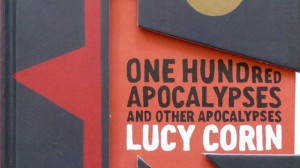“Like anything else, the thing about an apocalypse is it can’t go on forever, and this is what saves it and saves us in the end.” Lucy Corin’s apocalypses are not the final and complete destruction of the world, but — as she relates in the above quote from the one-page story “Wanting” — moments of change and realization. In her newest book, One Hundred Apocalypses and Other Apocalypses, Corin creates a series of dreamscapes in which the apocalypse becomes a set piece for melancholy, humorous, beautiful, and lonely ruminations.
One Hundred Apocalypses and Other Apocalypses is a collection of three short stories and 100 very short stories. The first, “Eyes of Dogs” is Corin’s take on a Hans Christian Andersen tale of a soldier returning from war. The language is fable-like, but the story delivers no happy ending, just the stark realization of a one-night stand completely devoid of any magical elements. In a sidebar to the main text, Corin offers up Andersen’s more traditional version with some narrative commentary, deciding the story is “all very plausible enough, except perhaps for the part about the flour.”
Corin’s dry wit builds in the collection’s second story, “Madmen,” set in an alternative world of institutionalized madness. In this reality, young men and women undergo a right of passage into adulthood by visiting a facility and selecting their very own madman to bring home and care for. Told in the young woman’s voice, the story leads the reader into the asylum of Dancing Fools and Cretins as if it were the most ordinary thing in the world, delicately balancing the narrator’s understanding of this acceptable social process with the discordant psychoses of her own nuclear family. “My parents are such a classic couple,” she states matter-of-factly. “They’ll either get divorced or he’ll get smaller and smaller and she’ll get bigger and bigger until they die.” The apocalypse in “Madmen” is a personal one, as the narrator’s childhood ends in more than one way. In this and the following story, “Godzilla Versus the Smog Monster,” Corin perfectly captures the inner monologues of her young narrators as they reflect on insular family dynamics.
In “Godzilla Versus the Smog Monster” the state of California is burning, but this is just background for the kinds of teenage dramas that exist separate from all natural or unnatural disasters. The world in this story is familiar, relatable, and the most realistic of the three longer sections in One Hundred Apocalypses, making it all the more jarring when the second half of the story collection begins “After so many people were washed away by the disasters‚”
The hundred stories that follow range from two sentences to three pages in length. Each captures a different tone, a different narrator, funny apocalypses, terribly sad apocalypses, and poetic ones. One is even an Amazon-like series of reviews of the made-up 2012 film Baby Alive, starring Sissy Spacek and a pack of reality TV stars from Teen Mom and 16 and Pregnant. If you want horror that blurs the line between fact and fiction (and John Stamos), this is the film for you.


